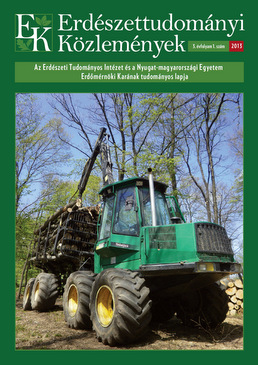| 1. | Ammer, C. 1996: Impact of ungulates on structure and dynamics of natural regeneration of mixed mountain forests in the Bavarian Alps. Forest Ecology and Management, 88: 43–53. DOI: 10.1016/s0378-1127(96)03808-x |
| 2. | Aszalós R.; Standovár T.; Ruff J. és Barton, Zs. 2004: A börzsönyi jégtörések okairól az országosan egyre nagyobb területet érintő jégtörések fényében. Erdő és Klíma Konferencia IV., Nyugat-Magyarországi Egyetem, Sopron, 249–262. |
| 3. | Aszalós, R.; Somodi, I.; Kenderes, K.; Ruff, J.; Czúcz, B. and Standovár, T. 2012: Accurate prediction of ice disturbance in European deciduous forests with generalized linear models: a comparison of field-based and airborne-based approaches. European Journal of Forest Research, 131: 1905–1915. DOI: 10.1007/s10342-012-0641-6 |
| 4. | Busing, R. T. and White, P. S. 1997: Species Diversity and Small-Scale Disturbance in an Old-Growth Temperate Forest: A Consideration of Gap Partitioning Concepts. Oikos, 78: 562–568. DOI: 10.2307/3545618 |
| 5. | Čermák, P.; Horsák, P.; Špiřík, M. and Mrkva, R. 2009: Relationships between browsing damage and woody species dominance. Journal of Forest Science, 55: 23–31. |
| 6. | Csépányi P. 2008: A tölgy és a folyamatos erdőborítás. Erdészeti Lapok, 143: 294–297. full text |
| 7. | Dövényi Z. (ed.) 2010: Magyarország kistájainak katasztere. MTA Földrajztudományi Kutatóintézet, Budapest. |
| 8. | Emborg, J. 1998: Understorey light conditions and regeneration with respect to the structural dynamics of a near-natural temperate deciduous forest in Denmark. Forest Ecology and Management, 106: 83–95. DOI: 10.1016/s0378-1127(97)00299-5 |
| 9. | Emborg, J.; Christensen, M. and Heilmann-Clausen, J. 2000: The structural dynamics of Suserup Skov, a near-natural temperate deciduous forest in Denmark. Forest Ecology and Management, 126: 173–189. DOI: 10.1016/s0378-1127(99)00094-8 |
| 10. | Frank, T. (ed.) 2000: Természet – Erdő – Gazdálkodás. Magyar Madártani és Természetvédelmi Egyesület és Pro Silva Hungaria Egyesület, Eger. |
| 11. | Gálhidy, L.; Mihók, B.; Hagyó, A.; Rajkai, K. and Standovár, T. 2006: Effects of gap size and associated changes in light and soil moisture on the understorey vegetation of a Hungarian beech forest. Plant Ecology, 183: 133–145. DOI: 10.1007/s11258-005-9012-4 |
| 12. | Gill, R. and Beardall, V. 2001: The impact of deer on woodlands: the effects of browsing and seed dispersal on vegetation structure and composition. Forestry, 74: 209–218. DOI: 10.1093/forestry/74.3.209 |
| 13. | Horváth Á.; Zsikla Á. és Hadvári M. 2010: A „Zsófia” ciklon meteorológiai leírása. Erdészeti Lapok, 145: 251–252. full text |
| 14. | Katona K.; Szemethy L.; Nyeste M.; Fodor Á.; Székely J.; Bleier N.; Kovács V.; Olajos T.; Terhes A. és Demes, T. 2007: A hazai erdők cserjeszintjének szerepe a nagyvad-erdő kapcsolatok alakulásában. Természetvédelmi Közlemények, 13: 119–126. |
| 15. | Kelemen, K.; Mihók, B.; Gálhidy, L. and Standovár, T. 2012: Dynamic response of herbaceous vegetation to gap opening in a Central European beech stand. Silva Fennica, 46: 53–65. DOI: 10.14214/sf.65 |
| 16. | Kenderes, K.; Aszalós, R.; Ruff, J.; Barton, Z. and Standovár, T. 2007: Effects of topography and tree stand characteristics on susceptibility of forests to natural disturbances (ice and wind) in the Börzsöny Mountains (Hungary). Community Ecology, 8: 209–220. DOI: 10.1556/comec.8.2007.2.7 |
| 17. | Kenderes, K.; Mihók, B. and Standovár, T. 2008: Thirty years of gap dynamics in a central European beech forest reserve. Forestry, 81: 111–123. DOI: 10.1093/forestry/cpn001 |
| 18. | Kenderes K. és Standovár T. 2007: Természetes lékek felújulásának vizsgálata a bükki Őserdő Erdőrezervátumban. Természetvédelmi Közlemények, 13: 101–108. |
| 19. | Mátrai K. és Szemethy L. 2000: A gímszarvas szezonális táplálékának jellegzetességei Magyarország különböző élőhelyein. Vadbiológia, 7: 1–9. |
| 20. | MgSzH 2007: A Diósjenő-Királyréti körzet erdőterve 2007–2016. Váci Erdőtervezői Iroda, Vác. |
| 21. | Mihók, B.; Gálhidy, L.; Kelemen, K. and Standovár, T. 2005: Study of Gap-phase Regeneration in a Managed Beech Forest: Relations between Tree Regeneration and Light, Substrate Features and Cover of Ground Vegetation. Acta Silvatica et Lignaria Hungarica, 1: 25–38. full text |
| 22. | Mihók, B.; Gálhidy, L.; Kenderes, K. and Standovár, T. 2007: Gap Regeneration Patterns in a Semi-natural Beech Forest Stand in Hungary. Acta Silvatica et Lignaria Hungarica, 3: 31–45. full text |
| 23. | Nagy J., 2007: A Börzsöny hegység edényes flórája. (Vascular flora of the Börzsöny Mountains). Duna-Ipoly Nemzeti Park Igazgatóság, Budapest. |
| 24. | Reininger H. 2010: A szálalás elvei. HM Budapesti Erdőgazdaság Zrt., Budapest. |
| 25. | Somogyi Z. 1998: A bolygatás jelensége, szerepe az erdei ökoszisztémákban és erdőművelési jelentősége. Erdészeti Kutatások, 88: 165–194. |
| 26. | Szabó I.; Horváth L. és Nagy L. 2009: A magas kőris hajtáspusztulása. Erdészeti Lapok, 144: 46–47. full text |
| 27. | The R Developement Core Team 2008: A Language and Environment for Statistical Computing. |
| 28. | Zinggeler, J. and Schwyzer, A. 2001: Game Browsing Damage Survey. 93–99. In: Brassel, P. and Lischke, H. (eds.), Swiss National Forest Inventory: Methods and Models of the Second Assessment, WSL Swiss Federal Research Institute. |
